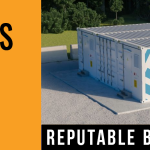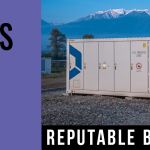 The small island nation of Palau in the western Pacific Ocean has moved a step closer to having what is said to be the largest ever microgrid spanning diesel, solar and battery energy storage.
The small island nation of Palau in the western Pacific Ocean has moved a step closer to having what is said to be the largest ever microgrid spanning diesel, solar and battery energy storage.
A 30-year power purchase agreement (PPA) has been signed with France-based ENGIE EPS, a microgrid and energy storage specialist arm of power giant ENGIE. The project was originally developed by US-based distributed energy provider GridMarket.
The system, known as ‘Armonia’, will include existing diesel generation alongside up to 35MW of solar, for which land has already been secured, and up to 45MWh of battery storage. On completion the Palau grid will then have an installed power capacity of 100MW and renewables will account for more than 45% of the country’s demand. Much of the current diesel usage will be displaced, thus reducing carbon emissions and generating substantial savings on Palau’s energy bill.
Palau is targeting 45% renewables by 2025 and a 22% reduction in its energy sector emissions below 2005 levels and the new microgrid is expected to help the island nation reach that goal five years ahead of schedule. The archipelago of several hundred islands in Micronesia had a population of 17,889 in 2017, according to an ENGIE EPS presentation.
GridMarket’s contribution to the project included deploying its machine-learning platform and predictive analytics to map out a national energy transition strategy specifically for Palau. It later selected ENGIE EPS to implement the project.
Construction is expected to begin by the end of this year with commissioning forecasted before the end of 2019. It has been funded by the International Renewable Energy Agency (IRENA) and Japan International Cooperation Agency (JICA).
read more
 SolarEdge Technologies Inc. keeps preparing for the solar + storage energy future, entering into definitive agreements to acquire a majority stake in Kokam Co. Ltd. Headquartered in South Korea and founded in 1989, Kokam is a provider of lithium-ion battery cells, batteries and energy storage solutions. SolarEdge develops “smart energy solutions,” including a DC-optimized PV inverter solution.
SolarEdge Technologies Inc. keeps preparing for the solar + storage energy future, entering into definitive agreements to acquire a majority stake in Kokam Co. Ltd. Headquartered in South Korea and founded in 1989, Kokam is a provider of lithium-ion battery cells, batteries and energy storage solutions. SolarEdge develops “smart energy solutions,” including a DC-optimized PV inverter solution. Toronto, Ontario, Oct 15, 2018 (Newsfile Corp via COMTEX) — Golden Share Resources Corporation (GSH) (“Golden Share” or the “Company”) announces that it has entered into an arrangement agreement (the “Arrangement Agreement”) with its wholly-owned subsidiary incorporated under Delaware law, Harmony Energy Technologies Corporation (“Spinco”), to transfer its energy storage business to Spinco under a plan of arrangement (the “Arrangement”).
Toronto, Ontario, Oct 15, 2018 (Newsfile Corp via COMTEX) — Golden Share Resources Corporation (GSH) (“Golden Share” or the “Company”) announces that it has entered into an arrangement agreement (the “Arrangement Agreement”) with its wholly-owned subsidiary incorporated under Delaware law, Harmony Energy Technologies Corporation (“Spinco”), to transfer its energy storage business to Spinco under a plan of arrangement (the “Arrangement”). Solar power now accounts for around 1% of the world’s electricity generation, up from a negligible amount of solar capacity only a decade ago. But that’s just scratching the surface of the industry’s potential. Solar energy is the most abundant form of energy on earth, with enough solar energy hitting the planet’s surface every hour to provide for all of humanity’s energy needs for a year.
Solar power now accounts for around 1% of the world’s electricity generation, up from a negligible amount of solar capacity only a decade ago. But that’s just scratching the surface of the industry’s potential. Solar energy is the most abundant form of energy on earth, with enough solar energy hitting the planet’s surface every hour to provide for all of humanity’s energy needs for a year. Israel-based smart energy and inverter company SolarEdge announced on Thursday its intention to acquire battery manufacturer Kokam in a deal expected to be worth approximately $88 million.
Israel-based smart energy and inverter company SolarEdge announced on Thursday its intention to acquire battery manufacturer Kokam in a deal expected to be worth approximately $88 million. A community energy project based on the south-west coast of Western Australia is offering households an opportunity to become 90 per cent renewable “for the price of a coffee a day” as part of a privately funded, potentially 6.5MW virtual power plant.
A community energy project based on the south-west coast of Western Australia is offering households an opportunity to become 90 per cent renewable “for the price of a coffee a day” as part of a privately funded, potentially 6.5MW virtual power plant. The lithium ride was a great one. Cobalt, too. All they needed was their Elon Musk moment, which came in the form of the Nevada battery gigafactory. The next Elon Musk moment won’t be about lithium at all—or even cobalt. It will be for an element that takes everything electric to its revolutionary finish line: Vanadium.
The lithium ride was a great one. Cobalt, too. All they needed was their Elon Musk moment, which came in the form of the Nevada battery gigafactory. The next Elon Musk moment won’t be about lithium at all—or even cobalt. It will be for an element that takes everything electric to its revolutionary finish line: Vanadium. UK energy storage and smart home specialist Moixa has this week unveiled a new ‘family-sized’ battery designed to help households take advantage of the growing number of time-of-use energy tariffs.
UK energy storage and smart home specialist Moixa has this week unveiled a new ‘family-sized’ battery designed to help households take advantage of the growing number of time-of-use energy tariffs. Schneider Electric has won a $5.2 million contract to provide a microgrid for the nation’s second busiest port, the Port of Long Beach in the city of Long Beach, California.
Schneider Electric has won a $5.2 million contract to provide a microgrid for the nation’s second busiest port, the Port of Long Beach in the city of Long Beach, California. Duke Energy’s advancement of battery energy storage technologies in the Carolinas includes $500 million of projects in the company’s 15-year forecast – continuing the company’s industry-leading deployment of the technology.
Duke Energy’s advancement of battery energy storage technologies in the Carolinas includes $500 million of projects in the company’s 15-year forecast – continuing the company’s industry-leading deployment of the technology.



